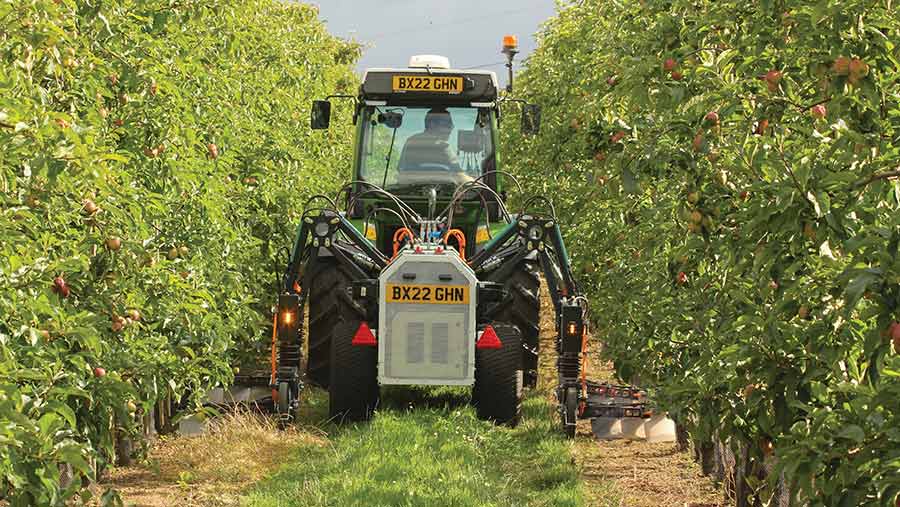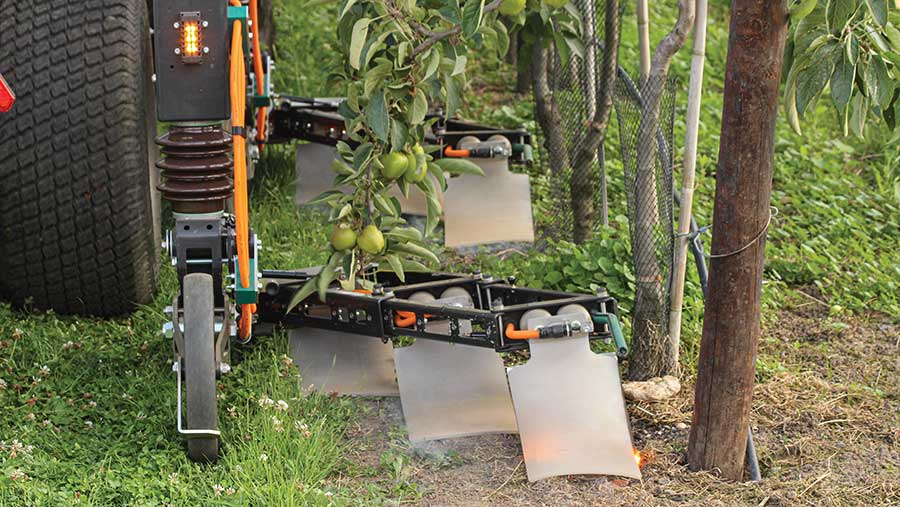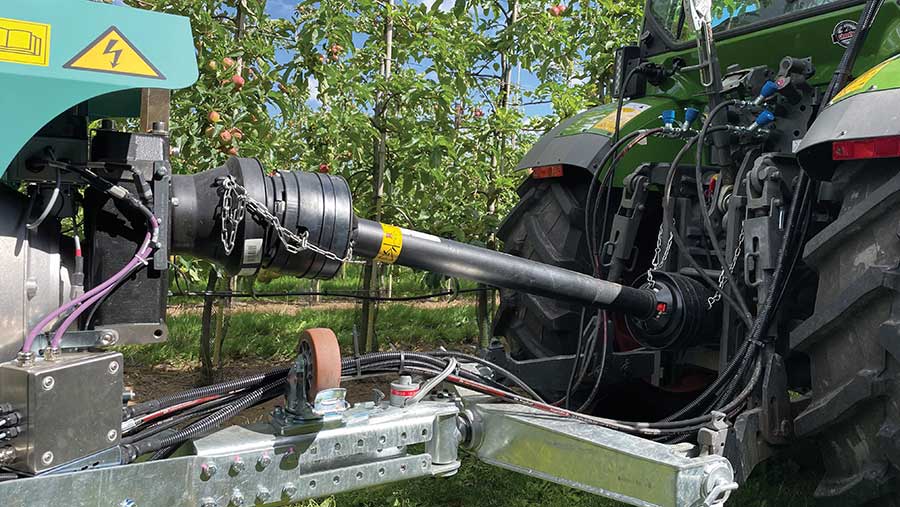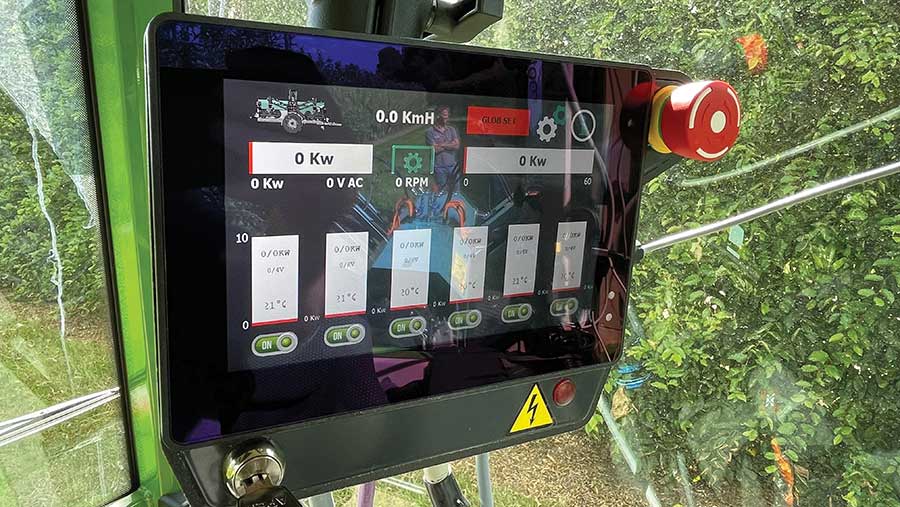RootWave demos new tractor-powered electric weeder
 © Adam Clark
© Adam Clark British e-weeding firm RootWave has launched its first tractor-powered machine for orchards and vineyards, with several already reserved by growers across the UK.
The technology promises to be safer than the alternatives, and although the upfront cost is hefty, this will be softened by eligibility for a grant through the Farming Equipment and Technology Fund (FETF).
See also: How alternative potato desiccation systems performed in 2022
Until now, RootWave has only been active in the amenity market with its handheld RootWave Pro, of which 150 units have been sold to the likes of Transport for London and English Heritage.
It is now offering its patented technology to the horticultural market with its RootWave Top Fruit.
The trailed unit is capable of working in orchards or vineyards with row widths of 1.8m to 4m and there are plans to offer a model with 6m reach for cider orchards that plant on wider rows.
The 1.2t machine has four electrodes arranged in pairs (front and rear). These are attached to two hydraulically folding arms that can be adjusted to treat a 30-50cm strip at the base of each row of trees.
When unfolded and in operation, suspended guide wheels keep the electrodes at the correct height to maintain a good connection with the ground and target weeds.
Electrode carriages move laterally on a passive spring system, which is designed to shift the electrode in and out of the crop row to ensure weeds are controlled intra-row.
Working speeds of up to 5kph can be achieved, depending on the weed burden.
Electricity is passed through weeds, mostly through the front electrode, with the rear offering a further zap before the electrical circuit is complete. The heat created kills the weeds down to the roots.

Electricity is passed through weeds, with the heat created killing weeds down to the roots © Adam Clark
Patented technology
Up to this point, the description of the technology is not unique. Zasso, owned by CNH, offers a similar linkage-mounted orchard electric weeder and German firm Crop.Zone sells an iteration targeted at potato desiccation.
Where RootWave has a point of difference is the type of electrical power it uses to kill weeds, which it claims is more efficient and much safer than its competitors.
It has long been understood that high-frequency alternating current (AC) poses much less risk of fatal injury from electric shock than lower-frequency AC or direct current (DC) electricity.
The RootWave Top Fruit has a pto-driven generator that produces 415V three-phase power and converts it to 18kHz AC current, which is 10,000 times less likely to cause cardiac arrest than mains 50Hz AC, and 2,500 times less likely than any DC device.
The firm says this makes its patented technology much safer than other electric weeders in the rare event of someone coming into contact with an electrode.
Dramatic improvements in semiconductor technology allowing better control of electrical current have enabled high-frequency AC to be applied in this way.
The improved control also means greater efficiency, with the machine’s Powermatch feature enabling its system to adjust power flow to each electrode individually.
If weed burden is higher on one side, power can be weighted to where it’s needed most through RootWave’s in-cab touchscreen terminal.

RootWave claims its pto-driven generator is more efficient and much safer than its competitors’ electrical power © Adam Clark
Working window
Top fruit growers use on average two-and-a-half weed control treatments a year, which could be all herbicides, mechanical methods – including cultivation, topping or high-pressure water weeders – or a mix of the two.
There are restrictions on how late herbicides can be applied in orchards, while carbon loss – increasingly important for sustainability targets – is an undesirable consequence of mechanical methods.
Spraying can’t be carried out in windy conditions, and mechanical options are brought to a halt by direct rain or wet soil conditions.
RootWave marketing manager Tom Archer says the Top Fruit machine solves most of these issues, as it doesn’t disturb soil and can run at any time except in direct rainfall, significantly extending its use window.
The company carried out analysis on a 50ha top fruit farm, comparing the cost of the machine versus a sprayer applying herbicides.
Pay back
Growers can expect to pay £89,000 for the Top Fruit, and after eight years the total cost of weed control will reach parity with a conventional system.
A potential £25,000 grant from Defra’s FETF would make the figures look more attractive, as would spreading the cost of depreciation over more hectares.
Running costs are low, with operators expected to change a set of electrodes each season, costing £300-£400.
“We know the machine is as efficient and can treat as many hectares per hour as a sprayer,” explains Tom.
“In fact, it can probably treat a bit more as you don’t need to stop to fill up with chemical and water.
“Some growers tell us it is potentially game changing for them, as they could reduce the number of tractors and workers they need.”
At a recent demonstration event in Kent, top fruit growers were enthusiastic about the launch machine, but one concern was the ability of the machine’s electrodes to overlap pass-to-pass and reach weeds intra-row.
As the Top Fruit is still a work in progress, this is one issue its engineers will be looking to overcome in the short term.

Power can be weighted to where it is needed most through RootWave’s in-cab touchscreen terminal © Adam Clark
Row crop machine
RootWave also has an early-stage prototype machine for precision-drilled row crops such as sugar beet and maize, which has produced good results in trials over the past couple of years.
The machine is likely to match and follow RTK-guided drills, so a 6m version could be the first step in commercialisation, although no timeframe for launch has been released.
It will be able to work close to the crop inter-row, with the challenge being whether intra-row weeding is possible using, for example, green-on-green weed recognition technology.
“It’s something we are confident we can solve and there are several options we are looking at already,” says RootWave’s Tom Archer.
If successful, a non-chemical approach in sugar beet could be a game-changer, as it has long been seen as a barrier to organically produced beet sugar due to the importance of weed control in producing a high-yielding, quality crop.

